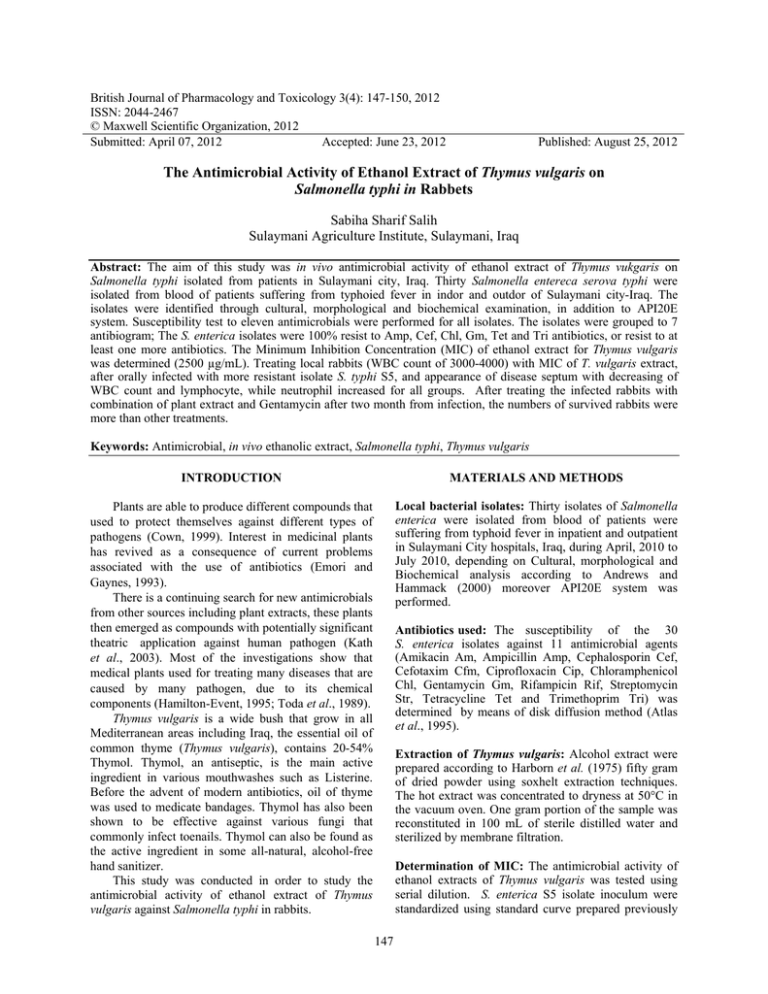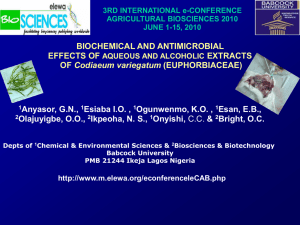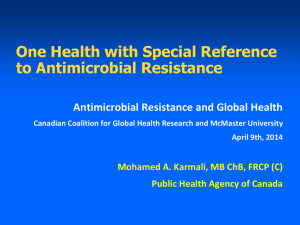British Journal of Pharmacology and Toxicology 3(4): 147-150, 2012 ISSN: 2044-2467
advertisement

British Journal of Pharmacology and Toxicology 3(4): 147-150, 2012 ISSN: 2044-2467 © Maxwell Scientific Organization, 2012 Submitted: April 07, 2012 Accepted: June 23, 2012 Published: August 25, 2012 The Antimicrobial Activity of Ethanol Extract of Thymus vulgaris on Salmonella typhi in Rabbets Sabiha Sharif Salih Sulaymani Agriculture Institute, Sulaymani, Iraq Abstract: The aim of this study was in vivo antimicrobial activity of ethanol extract of Thymus vukgaris on Salmonella typhi isolated from patients in Sulaymani city, Iraq. Thirty Salmonella entereca serova typhi were isolated from blood of patients suffering from typhoied fever in indor and outdor of Sulaymani city-Iraq. The isolates were identified through cultural, morphological and biochemical examination, in addition to API20E system. Susceptibility test to eleven antimicrobials were performed for all isolates. The isolates were grouped to 7 antibiogram; The S. enterica isolates were 100% resist to Amp, Cef, Chl, Gm, Tet and Tri antibiotics, or resist to at least one more antibiotics. The Minimum Inhibition Concentration (MIC) of ethanol extract for Thymus vulgaris was determined (2500 µg/mL). Treating local rabbits (WBC count of 3000-4000) with MIC of T. vulgaris extract, after orally infected with more resistant isolate S. typhi S5, and appearance of disease septum with decreasing of WBC count and lymphocyte, while neutrophil increased for all groups. After treating the infected rabbits with combination of plant extract and Gentamycin after two month from infection, the numbers of survived rabbits were more than other treatments. Keywords: Antimicrobial, in vivo ethanolic extract, Salmonella typhi, Thymus vulgaris INTRODUCTION MATERIALS AND METHODS Plants are able to produce different compounds that used to protect themselves against different types of pathogens (Cown, 1999). Interest in medicinal plants has revived as a consequence of current problems associated with the use of antibiotics (Emori and Gaynes, 1993). There is a continuing search for new antimicrobials from other sources including plant extracts, these plants then emerged as compounds with potentially significant theatric application against human pathogen (Kath et al., 2003). Most of the investigations show that medical plants used for treating many diseases that are caused by many pathogen, due to its chemical components (Hamilton-Event, 1995; Toda et al., 1989). Thymus vulgaris is a wide bush that grow in all Mediterranean areas including Iraq, the essential oil of common thyme (Thymus vulgaris), contains 20-54% Thymol. Thymol, an antiseptic, is the main active ingredient in various mouthwashes such as Listerine. Before the advent of modern antibiotics, oil of thyme was used to medicate bandages. Thymol has also been shown to be effective against various fungi that commonly infect toenails. Thymol can also be found as the active ingredient in some all-natural, alcohol-free hand sanitizer. This study was conducted in order to study the antimicrobial activity of ethanol extract of Thymus vulgaris against Salmonella typhi in rabbits. Local bacterial isolates: Thirty isolates of Salmonella enterica were isolated from blood of patients were suffering from typhoid fever in inpatient and outpatient in Sulaymani City hospitals, Iraq, during April, 2010 to July 2010, depending on Cultural, morphological and Biochemical analysis according to Andrews and Hammack (2000) moreover API20E system was performed. Antibiotics used: The susceptibility of the 30 S. enterica isolates against 11 antimicrobial agents (Amikacin Am, Ampicillin Amp, Cephalosporin Cef, Cefotaxim Cfm, Ciprofloxacin Cip, Chloramphenicol Chl, Gentamycin Gm, Rifampicin Rif, Streptomycin Str, Tetracycline Tet and Trimethoprim Tri) was determined by means of disk diffusion method (Atlas et al., 1995). Extraction of Thymus vulgaris: Alcohol extract were prepared according to Harborn et al. (1975) fifty gram of dried powder using soxhelt extraction techniques. The hot extract was concentrated to dryness at 50°C in the vacuum oven. One gram portion of the sample was reconstituted in 100 mL of sterile distilled water and sterilized by membrane filtration. Determination of MIC: The antimicrobial activity of ethanol extracts of Thymus vulgaris was tested using serial dilution. S. enterica S5 isolate inoculum were standardized using standard curve prepared previously 147 Br. J. Pharmacol. Toxicol., 3(4):147-150, 2012 as recommended by Cruickshank et al. (1975). Bacterial suspensions were further diluted to obtain the 1x105 CUF inoculum. Using spectrophotometric and by account of viable cells on nutrient agar (Atlas et al., 1995). Total WBC count: Blood samples were obtained from the rabbits, and put in heparinized tubes, mixed well, them the WBC was counted using culture instrument and classical way (Theml and Diem, 2004). In vivo effect of plant extract: Animals used in the experiment L: Adult Rabbits weighing 1.8-2.0 Kg, 5 month in age bred in our animal house in the normal environmental condition. In vivo antimicrobial activity: Orally Infected Rabbits with S. enterica S5 isolate of suspension containing 105-106 cells/mL (Song et al., 1997). The Rabbets were randomly divided into 4 groups, each containing 4 animals. When the symptoms of disease appeared, animals were administered the sub-MIC of plant extract three times in a day (1 mL from suspension) each time: The first group (disease control) received tap water only, the second group was infected with bacterial suspension, and the third group infected with bacteria and treated with sub-MIC of olant extract, the fourth group infected with bacteria and treated with Garamycin and the fifth group infected with bacteria and treated with sub-MIC of plant extract and Garamycin. Enumeration of S5 isolates cells in the blood: The number of bacteria in the blood of rabbets was performed according to Goden et al. (2005) and Kuo et al. (2005) during every 10 days from infection. The frequencies of WBC and deferential WBC were evaluated (Theml and Diem, 2004). Specimen preparation for light microscopy: Tissue selected for microscopy is removed from an animal and fixed by immersion in (usually) formaldehyde. The fixed tissue is washed, dehydrated in a series of increasingly concentrated solutions of ethanol, and embedded in wax. The wax impregnated block of tissue is chucked into the holder of a microtome, a device which (as the name implies) cuts very thin slices off the block. The tissue is stained, using the most common stain hematoxylin/eosin, which is really a combination of 2 dyes. Hematoxylin comes from the Peruvian logwood tree (Hematoxylin campechianum) (Merck, 2002). After staining has been completed, the slides were examined by the microscope. RESULTS Thirty isolates of Salmonella enterica were obtained from different blood of patients suffering from typhoid fever in in dor and out Dore of Sulaymani hospitals in Sulaymani city, Iraq. These isolates were identified culturally, morphologically and biochemically. The API 20E system was performed to support the identification process. These isolates were screened for eleven antibiotics, and according to the type and number of antimicrobial resistance S. enterica isolates were grouped to 7 antibiogram Table 1, The S. enterica isolates were 100% resist to Amp, Cef, Chl, Gm, Tet and Tri antibiotics, and differed in resistance to Ak, Cfm, Rif, Cip, Str. All isolates are multiresistant (resist to more than 2 antibiotics). Table 1: Antibiogram of S. entereca isolated from blood of patient seafaring from typhoid fiver Antibiotics Antibiogram ------------------------------------------------------------------------------------------------------------groups of L+S. typhi Isolates number Ak Chl Amp Cef Cfm Rif Gm Cip str Tet Tri 1 5, 8, 9, 11, 12, 15, 18, 19, R R R R R R R R R R R 21, 24, 26, 27, 28 2 3, 10 S R R R R R R R R R R 3 20, 25 R R R R S S R R R R R 4 7, 13, 16, 17, 22, 29, 30 S R R R S R R R R R R 5 14, 23 S R R R S S R R R R R 6 2 S R R R R S R S S R R 7 1, 4, 6 S R R R S S R S R R R L- S. typhi isolates S S R S S R S S R R R R: Resist to antibiotics; S: Sensitive to antibiotics Table 2: The MIC of alcoholic extract of T. vulgaris on S. typhi S5 isolate Plant extract Concentration of T. vulgaris µg/mL ---------------------------------------------------------------------------------------------------------------------------------------------Alcoholic extract 1500 1750 2000 2500 3000 2500 3750 4000 1.32 1.28 1.19 1.09 1.08 0.96 0.52 0.21 148 Br. J. Pharmacol. Toxicol., 3(4):147-150, 2012 Table 3: Total white blood cells, neutrophil, lymphocyte and number of bacteria in the blood of infected and uninfected rats with S. typhi S5 isolate Neutrophils Lymphocyte Bacterial Groups WBC (%) (%) growth At zero time 1* 5200 65 35 Negative 2 6000 70 30 Negative 3 6500 54 46 Negative 4 7000 60 40 Negative 5 8500 68 32 Negative After 10 days from infection 1 3600 72 28 Positive 2 3000 75 25 Positive 3 3200 78 22 Positive 4 4000 70 30 Positive 5 4800 74 26 Positive *: 1........., 2............, 3.............., 4............., 5............. The MIC of alcoholic Thymus vulgaris extract 2500 µg/mL for S5 isolate Table 2, cleared that alcoholic extract of Thymus vulgaris has in Vitro antimicrobial activity. To evaluate the effect of Thymus vulgaris extract on S. enterica in vivo, Rabbits were orally infected with S. enterica, after 7 days the symptoms of disease appeared (Animals are sicken fevers increased they dranked more water comparing with the control and unable to eating, and they become weak). The total WBC counts at zero time from infection were ranged between 5200 to 8500 for different groups Table 3 w. The Neutrophils % ere ranged between 54-70%, and Lymphocyte % were 30 to 46%, while the present of salmonella bacteria was zero (no growth of bacteria observed on MacConkey agar). After 10 days from infection the total WBC for group 1 become 3600 from 5200, and for group 2, 3, 4 and 5 the total WBC become 3000, 3200, 4000 and 4800, this mean that the total WBC decreased for all groups, on the other hand the percent of Neutrophils in the blood of infected and infected and treated with antibiotic or in infected and treated with antibiotic with MIC of T. vulgaris also increased from 65,70, 54, 60 and 68% to 72, 75, 78, 70 and 74% for group 1 to 5, respectively. Lymphocyte for all groups decreased after 10 days from infection and total Lymphocyte percent were decreased from 30-46 to 22-30%, respectively. After streaking the blood from all groups on all plates from all MacConkey agar groups were positive (Salmonella colonies were developed), even in the control group (uninfected grouo). While at zero time there were no growth observed Table 3. DISCUSSION Thirty Salmonella enterica isolated from blood of indoor and outdoor Hospitals in Sulaymani city. Isolated bacteria were screened for eleven antibiotics, and the results appeared that most isolates were resist to most antibiotics. The isolates considered multiresistant bacteria. In order to examine the effect of alcoholic extracts (Palaniappan and Holley, 2010) of T. vulgaris in vivo on reduction of antibiotic resistant action, local rabbits were used, and infected orally with 1×105-6 CFU/mL suspension of S. typhi S5 isolate. After 7 days of infection, the symptom of disease appeared on infected rabbits, such as sicken fevers increased they dinked more water comparing with the control and unable to eating, and they become weak. The total WBCs count decreased from 5200-8500 to 3000-4800 cells µL1 as shown in Table 3 the type of neutrophil also elevated and raised from 54-70 to 70-78%, respectively. The WBCs used as an immunological parameters to determine the case of infection (Provan et al., 2004), while normal range of total WBCs were 4000 cells µL1 (Hoffman et al., 2000; Provan et al., 2004), because the main type of phagocytic cells which is required to participate in the phagocytosis in the ingestion of foreign bodies (like bacterial cells) are neutrophil and macrophage (Kern, 2002; Henderson and Oyston, 2003; Event and Stendahl, 2006), so during infection with bacteria, the range of neutrophils increased comparing with the control. While Lymphocyte has a role in immunity and decreased for all groups. As it is clear from the Table 3 that control group animals (un infected animals) behaved as infected groups, this was due to symptom of disease appeared on control animals, because all groups were in same room, and the groups were separated in specific cabinet inside the room and these animals infected from other groups and 3 of the animals from control group died because of severe infection. Searching for presence of S. typhi in the blood of animals all the groups were positive and the colonies of S. typhi developed when agar plate screened for bacterial growth including control group animals. The effect of MIC of T. vulgaris and Gentamycin were evaluated through the number of survived animals of each group, after 14 days from infection and when the animals received medication with Gentamycin, MIC, Gm + MIC up to day 30 from infection, the number of survived animals were 3 Rates for each group. After 60 days from infection the number of rates were 3 rates remain for group that received Gm + MIC and screening for bacterial growth appeared that there was no bacteria in the blood of animals, while fore groups receiving Gm or MIC alone 2 rates were survived, with present of bacteria in the blood. For group animals that infected and not received any medication only 1 rate 149 Br. J. Pharmacol. Toxicol., 3(4):147-150, 2012 Table 4: Bacterial growth and number of survived rates months from infection Bacterial No. of survived Groups growth rates 1 control (infected latter) + 1 2 GM+MIC 3 3 GM + 2 4 MIC + 2 5 only S. typhi + 1 survived, and that one was suffered from typhoid fever symptoms. When screened for bacterial growth the plates were positive Table 4. These findings have cleared demonstrated that the clearance of S. typhi from the blood of infection rates by combination of alcoholic extract (Adel and Sabiha, 2010) and Gentamycin was zero, as compared with the infected untreated rates, and the number of died animals decreased, furthermore it was more effective than other treatments. Similar results obtained when ethanol extract of other medicinal plant extracts used to inhibition of S. typhi in Vitro (Elegalam and Ekwenye, 2005). REFERENCES Adel, K.K. and S.S. Sabiha, 2010. Genetic site determination of antibiotic resistance genes in Pseudomonas aeruginosa by genetic transformation. Br. J. Pharmacol. Toxicol., 1(2): 85-89. Andrews, W.H. and T. Hammack, 2000. Bacteriological Analytical Manual. FDA, US Food and Drug Administration. Atlas, R.M., A.E. Brown and L.C. Parks, 1995. Laboratory Manual Experimental Microbiology. Mosby-Year Book Inc., St Louis. Cown, M.M., 1999. Plant products on antimicrobial agent. Clinical Microbial. Rev., 12: 564-582. Cruickshank, R., J.P. Duguid, B.P. Marmion and R.H.A. Swain, 1975. Medical Microbiology. 12th Edn., Churchill Livingstone, London, 2: 236, 432-434. Elegalam, N.N. and U.N. Ekwenye, 2005. Antimicrobial activity of ginger (Zingiber officinale Roscoe and Garlic Allium sativum L.) extracts on E. coli and Salmonella typhi. Intr. J. Molecu. Medici. Adv. Sci., 1(4): 411-416. Emori, T.G. and R.P. Gaynes, 1993. An overview of nosocomial infections, including the role of the microbiology laboratory. Clin. Microb. Rev., 6: 428-442. Event, J.D. and O. Stendahl, 2006. Phagocytosis of Bacteria and Bacterial Pathogenicity. Cambridge University Press, Cambridge, pp: 286, ISBN: 0521845696. Goden, B., E. Touitou, E. Rubenstein, A. Athamna and M. Athamna, 2005. A new approach for a treatment of deep skin infection by an ethosomal antibiotic preparation: An in vivo study. J. Antimicrob. Chemother., 55: 989-994. Hamilton-Event, J.M., 1995. Miner view, antimicrobials properties of tea (Camellia sinensis). Antimicrob. Agent Chemother., 39(11): 2375-2377. Harborn, J.B., T.J. Mabray and H. Mabray, 1975. Physical and Function of Flavonoids. Academic Press, New York. Henderson, B. and P.C.F. Oyston, 2003. Bacterial Evasion of Host Immune Responses: Advanced in Molecular and Cellular Microbiology 2. Cambridge University Press, United Kingdom. Hoffman, R., E.J. Benz, S.J. Shatill, B. Furie, H.J. Cohn, et al., 2000. Hematology: Basic Principles and Practice. 4th Edn., Elselvier Inc., London. Kath, W., S. Honnef and A. Heym, 2003. Medical and Aromatic Plant in Albania. Bosnia-Herzegovnia, Bulgaria, Croatia and Romania. Kern, W.F., 2002. PDQ (Pretty Darned Quick) Hematology. BC Decker Inc., Hamilton, London, Ethmobotanicald, 12: 42-48. Kuo, C.F., C.C. Chen, Y.H. Luo, R.Y. Haung and Chuang, et al., 2005. Cordyceps sinensis mycelium protects mice from group a streptococcal infection. J. Med. Microb., 54: 795-802. Merck Source, 2002. Dorlanaglind's Medical Dictionary. Palaniappan, K. and R.A. Holley, 2010. Use of natural antimicrobials to increase antibiotic susceptibility of drug resistant bcteria. Int. J. Food Microbiol., 140(2-3): 164-168, DOI: 10.1016/ j.ijfoodmicro.2010.04.001. Provan, D., C.R.J. Singer, T. Baglin and J. Lilleyman, 2004. Oxford Handbook of Clinical Hematology. Oxford University Press, New York, ISBN-13: 9780199227396. Song, Z., H.K. Johansen, V. Faber, C. Moser, A. Harazm, et al., 1997. Ginseng treatment reduces bacterial load and lung pathology in chronic\pseudomonas aeruginosa pneumonia in rats. Antimicrob. Agents Ch., 41(5): 961-964. Theml, H. and H. Diem, 2004. Color Atlas of Hematology. 2nd Edn., Thieme, Stuttgart, pp: 208, ISBN: 1604061464. Toda, M., S. Okubo, R. Hiyoshi and T. Shimamura, 1989. The bacterial activity of rea and coffee. Lett. Appl. Microbiol., 8: 123-125. 150






